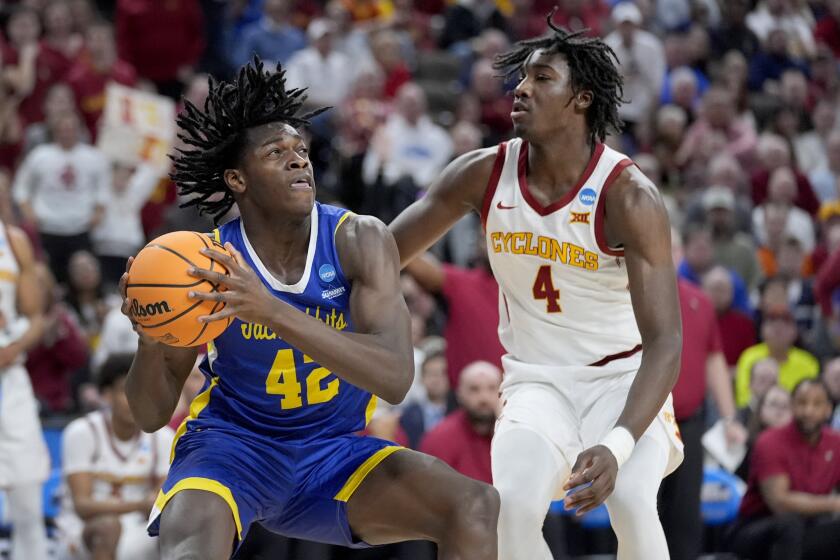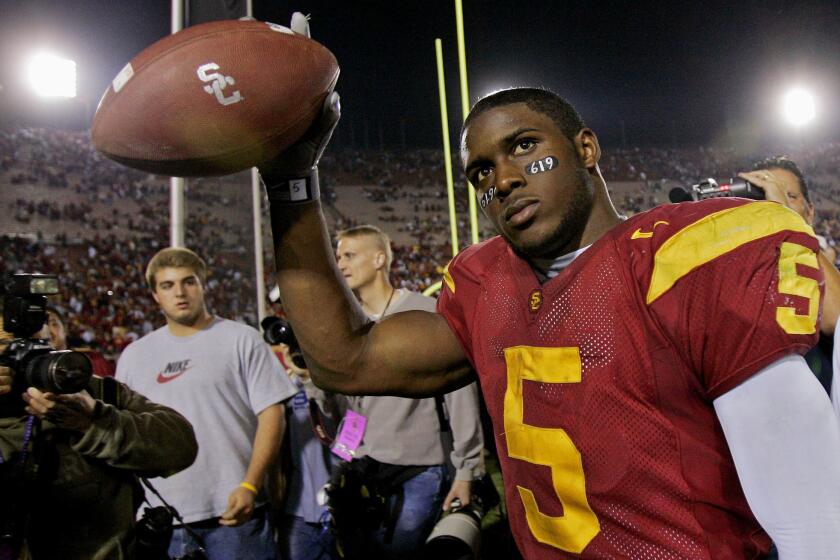Dodger Stadium welcomes mountains of dirt for AMA Supercross Series
Dave Prater and his crew began systematically killing the grass at Dodger Stadium this week, and no one from the Dodgers protested.
Prater did so by spreading 5,000 cubic yards of dirt — about 500 dump-truck loads equal to about 1.5 million pounds — over the field to create a track of berms and moguls and jumps for Saturday night’s Monster Energy AMA Supercross Series races, which will be held for the first time at the home of the Dodgers.
They also plan a Monster Jam truck event there Feb. 19, so the field will remain covered with Prater’s dirt for about five weeks.
“The grass is dead when we come off of it,” said Prater, director of supercross for Feld Entertainment. “But once we’re off, they’ll bring in a sod cutter … and lay a brand-new field.”
Dodger Stadium has been used for non-baseball events nearly since it opened in 1962. The Beatles, Elton John and Michael Jackson are just a few of the artists who have performed there. Pope John Paul II celebrated Mass at Dodger Stadium in 1987.
But this will be the first visit there by supercross, the stadium version of off-road motorcycle racing, or motocross. The sport’s big-name riders such as James Stewart, Ryan Dungey and Ryan Villopoto race around specifically designed tracks that feature several small hills, some of which cause the riders to take leaps two or three stories high before they land again.
It’s a popular sport, especially in Southern California, that often draws a crowd of 40,000 or more to a race. One of its leading venues is Angel Stadium in Anaheim, where in recent years supercross would hold three races early in the season.
Supercross spent years talking with Dodger Stadium about holding a race in Chavez Ravine as well, but it was only this year that the Dodgers — long wary of anyone tampering with their field — finally agreed. So this season supercross is racing twice in Anaheim and once in Los Angeles.
“We’ve been talking to [the Dodgers] on and off, and finally got to a point where it was really their comfort with us that we would adequately take care of the place and leave it in good shape when we got done,” said Ken Hudgens, Feld’s chief financial officer for motor sports.
“You’re talking about taking this into the home of one of the most pristine fields in the world,” he said. “They have groundskeepers whose 365-day-a-year job is to keep this field pristine, and then you’re going to go and dump 500 truckloads of dirt.”
In exchange, Saturday night’s races — there are heats in both supercross and its second-tier supercross lites division before the main event — present what could be a million-dollar night for both Feld and the Dodgers.
Although both parties declined to reveal details of their contract, they said the payoff is determined by attendance, and that it’s not a simple matter of Feld paying a flat rental fee to the Dodgers for using the stadium.
“It’s not a true partnership but we’re in it together,” Hudgens said. “Generally the Dodgers are keeping their parking revenue and their food and beverage [revenue], and we’re taking a percentage of our merchandise sales and a percentage of ticket sales. The better the business is, the better the Dodgers do, the better we do.”
Supercross events also sometimes feature pre-race tailgating parties in the parking lot. But those are prohibited at Dodger Stadium.
Given the recent publicity about the financial problems and divorce of Dodgers owner Frank McCourt, the question arises whether the Dodgers finally struck a deal with supercross because the team needs the money.
“No,” said Dodgers spokesman Josh Rawitch. “The Dodgers have for the last, probably, decade been looking for ways to help generate revenue at the stadium, independent of any other news you may be following.”
“We are always going to be very protective of the field,” he said, adding that the Dodgers were finally persuaded that after supercross leaves, “the stadium was going to look exactly the same on opening day [March 31] as it did the day the season ended.”
Prater’s crew first covered the field in plastic and then trucked their dirt — a mixture of 60% clay and 40% sand — from a stockpile in Carson to the Dodger Stadium parking lot behind center field. Dump trucks then took turns moving the dirt into the stadium.
From there, front-end loaders and bulldozers moved the dirt around to shape the track. They also covered the baseball field’s warning track with plywood. Lighting and sound equipment followed because pre-race festivities at supercross races typically include laser shows and fireworks.
“There aren’t many more prestigious places in the world than Dodger Stadium,” Hudgens said, “and to be able to take our event there is really quite a treat for us.”
More to Read
Get our high school sports newsletter
Prep Rally is devoted to the SoCal high school sports experience, bringing you scores, stories and a behind-the-scenes look at what makes prep sports so popular.
You may occasionally receive promotional content from the Los Angeles Times.






